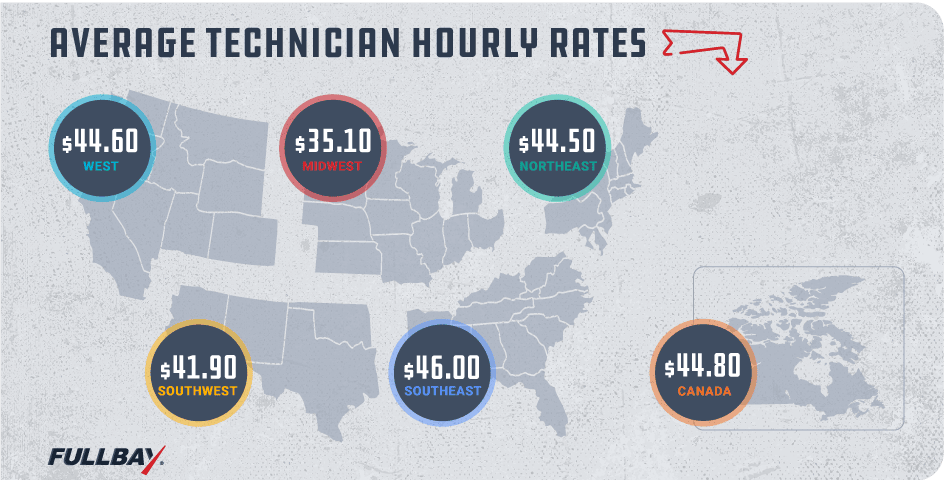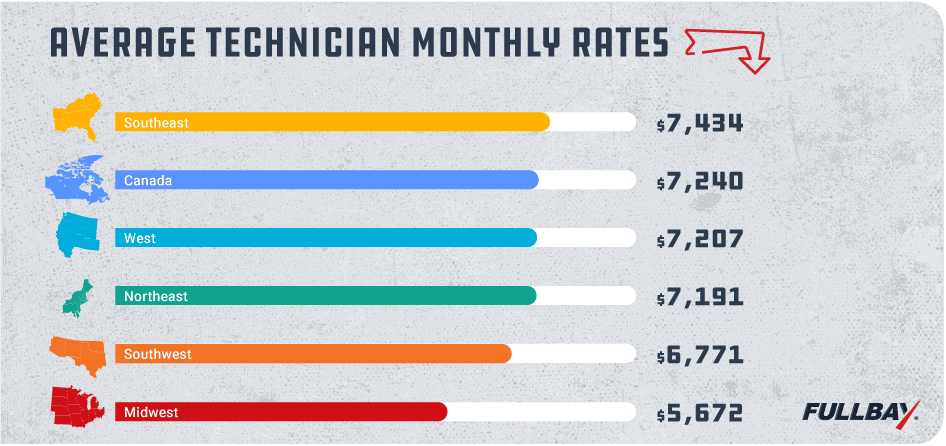In Which We Revisit Tech Wages

We’ve had some interesting responses to the 2022-23 edition of the State of Heavy-Duty Repair report—primarily around the issue of tech wages.
“These numbers seem high,” a few wrote in.
“These are really low,” others said.
Hmm.
We knew we had to investigate this disparity. We also knew we hadn’t talked to Jay Goninen, Co-Founder and President of WrenchWay, in a while, and this kind of question is right in his wheelhouse.
What follows is not the answer to all the industry’s problems. Or even an answer to the pay problem.
But it is a place to start.
THE STATE OF DIESEL TECHNICIAN WAGES
Before we go any further, let’s review the data from the report. Below is a graph depicting hourly wages in 2022:

As you can see, the highest-paid techs in the country were in the Southeast, and they earned an average of $46/hour. This led to an average of $7,434 a month in average salary:

WHAT DO HIRING AND PAY LOOK LIKE IN 2023?
We are still kind of early in 2023. The year is zipping along, but hey, it’s only April. Still, we figured that might be enough time for Jay and the WrenchWay team to notice any shifts in the way shops were advertising salaries and benefits.
“There’s upward pressure on salaries,” Jay tells us. “As we struggle to find experienced technicians, the level of pay is going up. It’s basic supply and demand.”
Remember, the tech shortage didn’t magically resolve itself in 2022. The diesel industry still has way more work than it has technicians to do said work. The available jobs are not all being filled by qualified applicants. So shop owners are (sometimes reluctantly) offering higher wages.
The thing is, a lot of shops aren’t telling applicants about these higher wages. Like they’re not advertising it at all. A tech has no idea what kind of salary might be available when they interview. Maybe it’s a lot; maybe it’s not.
“A lot of shops still aren’t very transparent,” Jay says. “On some level, it may be out of insecurity—they don’t know if they’re competitive, and that makes them a little gun-shy about advertising it.”
Part of the problem, of course, is shop owners aren’t exactly talking amongst themselves about salaries. It seems to be a conversational black hole. So they don’t know what their competitors are offering, and they don’t know what they themselves should be offering.
Quite a conundrum!
YOUR TECHS TALK ABOUT SALARY
Here’s the problem: Just because owners aren’t talking doesn’t mean techs aren’t talking.
And techs talk!
WrenchWay did a round table last fall where Jay asked several techs how well they know what their peers are making and what their competitors are paying.
“They basically know what every shop around them pays, or they have a good idea,” Jay laughs. He shares a story that is probably common in repair shops across the country: when a new tech joins the team, his colleagues take him out, get him a beer, and quiz him on his salary history.
If a shop isn’t transparent about salaries, they’re automatically at a disadvantage. The techs will know if they’re being overpaid or underpaid. They also know exactly who’s offering more cheddar.
THE VALUE OF A WAGE
So…how can a shop owner know if they’re over- or under-paying their techs?
Jay recommends a competitive analysis.
“You have to do research and go beyond a gut feel,” he says. He suggests diving into this research quarterly, even if you’re not actively hiring anybody, so you can keep up with what others are paying.
This brings us to a question we’ve heard a few times, usually attached to our articles suggesting owners should give their techs raises: “How can I get a tech to provide the value of the wage he desires?”
As much as we’d like to give you a list of steps to follow to reach that value, the truth is there isn’t a perfect answer to this question. It’s really kind of an awkward dance. You need to be competitive. Your local market, to a point, determines what is competitive. Your techs may be very loyal to you, but if you’re underpaying them, they will eventually go elsewhere. That’s just life and the nature of the economy. Many shop owners are still going with their gut instinct, thinking, “Wow, this hourly demand is way too much.”
But it’s not too much if your competitors will pay it.
Keep performing competitive analysis. Look into what the shop down the street and across town is offering. Beyond that, look at what you’re charging for your services. Should you raise your labor rate? Should you offer more services—or cut down on those you aren’t making a lot on? Should you up your marketing efforts to bring in more customers? Should you charge more for what you offer?
Think about that last one for a moment. If you aren’t charging your customers enough, you won’t be competitive with pay. To offer more benefits and a competitive salary, a shop needs to make good money—so, are you charging enough?
YOUNGER SHOPS ARE CHANGING THE TIDE
One of the things we found interesting in the report was the revelation around bonuses. Specifically, younger shops (five and under) were providing bigger and more bonuses than older, better-established shops.
We wondered if younger shops were owned by younger owners—people who remembered, perhaps, not getting big raises or bonuses.
Jay agreed that could be part of it. But, he points out, “A lot of technicians [and a lot of people in general] crave stability, and a business that’s been around for a long time.”
There’s a lot to be said for stability. A steady paycheck that you know will be there next week, next month, next year. Steady health insurance. Plenty of PTO. These are all things most of us crave for ourselves and our families. A bigger, more established operation can offer those things; a younger shop may not have the pull to do so (or the visibility).
That means they have to get creative to draw talent and stand out.
So they get creative with bonuses, with flexible hours, and other benefits. They’re generally open to trying new things. Some of the younger shop owners have received business coaching, part of which is going to involve paying competitive wages and bonuses.
REMAIN OPEN TO TRYING NEW THINGS
As our conversation came to a close, Jay reflected on a trait he sees in most successful business owners: willingness to try new things and openness to learning more.
Some folks think that because something has worked for years, they don’t need to change. You see a lot of that in the stereotypical business owner who thinks things are their way or the highway. But the world changes. Things shift. You’ve got to be willing to shift with it and remain open to trying new things if you want your business to have any sort of longevity.
If nothing else, we hope that’s what you take away from this article: stay open-minded about wages and salaries*. If it looks like you should be paying them more, do everything in your power to pay them more. They’re worth it.
*And honestly, everything else. BIGFOOT LIVES!

